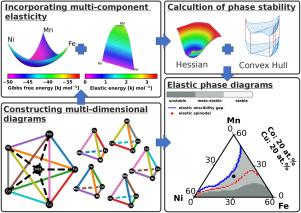Incorporating elasticity into the thermodynamics and phase diagrams of multi-component systems
IF 2.9
Q2 MATERIALS SCIENCE, MULTIDISCIPLINARY
引用次数: 0
Abstract
Elastic energy plays a critical role in determining phase stability in compositionally complex alloys. However, quantifying elastic contributions in multi-component systems and incorporating them into phase diagram construction remain challenging. In this study, we present a generalized elastic energy formalism tailored for multi-component alloys, which can be directly and efficiently integrated with CALPHAD thermodynamic databases and existing frameworks such as Thermo-Calc (Andersson et al., 2002), Pandat (Cao et al., 2009) or FactSage (Bale et al., 2016). This elasticity formalism can also be introduced as a post-processing layer in open-source software such as pyCALPHAD (Otis and Liu, 2017) and Kawin (Ury et al., 2023) , enabling elastic assessments in multi-component systems.
We apply our framework for constructing the phase diagram of quinary Fe–Mn–Ni–Co–Cu alloy system, utilizing convex hull and Hessian matrix under elastic considerations. Our results reveal that incorporating elastic energy leads to an expansion of both the spinodal region and the miscibility gap. These are governed by the intricate interplay of chemical and elastic driving forces: We found that Mn and Ni contribute strongly to chemical stabilization, while Cu and Co tend to destabilize the alloy, especially at low Mn concentrations. The stabilizing effect of Fe is also pronounced in Mn-deficient regions. Acting as a destabilizing factor, the elastic energy is primarily driven by the presence of Mn, underscoring its multifaceted role in thermodynamic stability. In Mn-rich compositions, Cu markedly reduces the elastic energy contribution. Combined with CALPHAD infrastructures, the current framework offers a practical pathway to improve the predictive accuracy of phase stability and transformations in complex multi-component alloys.

将弹性纳入多组分系统的热力学和相图
在复杂合金中,弹性能是决定相稳定性的关键因素。然而,量化多组分系统中的弹性贡献并将其纳入相图构建仍然具有挑战性。在本研究中,我们提出了一种针对多组分合金的广义弹性能量形式,该形式可以直接有效地与CALPHAD热力学数据库和现有框架(如thermal - calc (Andersson等人,2002)、Pandat (Cao等人,2009)或FactSage (Bale等人,2016)集成。这种弹性形式也可以作为后处理层引入开源软件,如pyCALPHAD (Otis and Liu, 2017)和Kawin (Ury et al., 2023),从而可以在多组件系统中进行弹性评估。在弹性条件下,利用凸包和Hessian矩阵,应用我们的框架构造了Fe-Mn-Ni-Co-Cu合金体系的相图。我们的研究结果表明,加入弹性能会导致旋多区和混相间隙的扩大。这些是由化学和弹性驱动力的复杂相互作用所控制的:我们发现Mn和Ni对化学稳定有很强的贡献,而Cu和Co倾向于破坏合金的稳定,特别是在低Mn浓度下。铁的稳定作用在缺锰地区也很明显。作为一个不稳定因素,弹性能主要是由Mn的存在驱动的,强调了它在热力学稳定性中的多方面作用。在富锰组分中,Cu显著降低了弹性能的贡献。结合CALPHAD基础结构,目前的框架为提高复杂多组分合金相稳定性和相变的预测精度提供了一条实用的途径。
本文章由计算机程序翻译,如有差异,请以英文原文为准。
求助全文
约1分钟内获得全文
求助全文
来源期刊

Materialia
MATERIALS SCIENCE, MULTIDISCIPLINARY-
CiteScore
6.40
自引率
2.90%
发文量
345
审稿时长
36 days
期刊介绍:
Materialia is a multidisciplinary journal of materials science and engineering that publishes original peer-reviewed research articles. Articles in Materialia advance the understanding of the relationship between processing, structure, property, and function of materials.
Materialia publishes full-length research articles, review articles, and letters (short communications). In addition to receiving direct submissions, Materialia also accepts transfers from Acta Materialia, Inc. partner journals. Materialia offers authors the choice to publish on an open access model (with author fee), or on a subscription model (with no author fee).
 求助内容:
求助内容: 应助结果提醒方式:
应助结果提醒方式:


